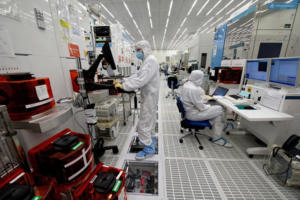
Silicon was any electronics enthusiast’s trusted companion. Since the discovery of properties of the semiconductor, the electronics industry began thriving. Till date, the one place we never curb to spend on is this. But have we ever worried about the internal structure or the nasty electron’s behavior? Looks like the scientists have done a really great job. The electronic top-down approach, stops at the digital unit memory blocks and gates, seldom delving into the nuances of the analog signals which operate.
But currently, there has been an increasing trend towards using alternate materials instead of silicon. But why?
The reason we abandoned the old friend- Silicon?
Silicon, when doped with the right compounds, can create wonders. But the researchers faced flak when it came to integrating the chip into boards, size, optimization, heat tolerance, and speed. The Moore’s law claims that the number of transistors on a chip will double every 18-24 months. However, now it has become increasingly difficult to reduce the size of silicon.
Packaging efficiency is highly qualified because of the thick layers in it. Silicon is also inefficient in converting light energy to electrical energy and vice versa. When this application is meted out using LEDs, solar panels, and photodiodes, which form an integral part of alternative energy and the sensors, the power efficiency drops. The very motive of them is demoted.
The refining and manufacturing price of Silicon wafer is also exorbitant. Moreover, Silicon provides lesser speed, creating a bottleneck for the photo materials. As a result, when the industry is demanding speeds as a fraction of that of light, there needs to be some serious thought put into the replacement of Silicon.
Wafers Ft.- alternate materials
Graphene: Remember the lead present in pencils. Now imagine picking just one layer out of it. There you go! You have Graphene in your hand. It is a zero-gap semiconductor, which makes it superconductive. It seems a bane, and hence, scientists have tried to introduce band gap into it. Graphene is much faster than silicon. It also uses less power. As a result, it is seen as the next stop for optical storage, and photovoltaic cells.
Gallium Arsenide: To overcome the poor energy conversion properties of Silicon, the Gallium Arsenide shows a viable option. Electrons also work their magic at a much faster pace, because the structure of Gallium Arsenide provides it to have a higher mobility of electrons and velocity saturation. It is relatively insensitive to heat. It is also a highly photosensitive material. This enables GaAs to be a part of Microwave integrated circuits, solar cells, laser cells, and more.
Black Phosphorous: A thermodynamically stable form of phosphorous, with a structure similar to graphite, Black Phosphorous (BP) provides scope for higher speed. BP is only a few layers thick, which makes it easier to pack, and hence more energy efficient. With the upcoming Internet of Things requiring minute devices, BP can be used to provide the long-term power solution. The sensors can have a high rate of autonomous data recording and transmission.
Organic Semiconductors: Organic Semiconductors, are polymers of carbon and hydrogen, which are often doped with oxygen, nitrogen, and sulfur. When stimulated rightly, they form semiconductors. They have low dielectric constants, are electronically ‘soft’, and are easy to deposit. With cheaper production costs, and flexibility in design, and mechanical deformability, which enables them to become wearables. Already a part of OLED screens, researchers are looking for ways to boost the electrical activity of the same.
Diamond: The production of synthetic diamonds by chemical vapor deposition envisions a new age a wide bandgap semiconductor technology. Its optical properties and inclination to the low coefficient of thermal expansion and thermal conductivity make it a good window material. As it has a higher breakdown voltage, it can be used in high-frequency applications and high power devices.
Having listed out a few alternate semiconductor materials, there is a lot more research going on about the same. The profundity towards optoelectronics and alternate energy with least energy consumption has led to a plethora of opportunities for even the most unexpected of material undergoing a metamorphosis towards becoming the next Silicon. 50 years ago, a place was named Silicon Valley, due to the abundance of silicon-based industries. I would not be surprised if 50 years from now, a new hub is called Organic Valley- highly misleading, nevertheless awe-inspiring.















